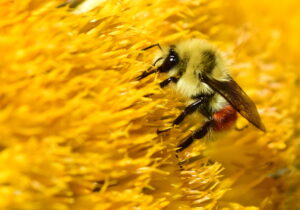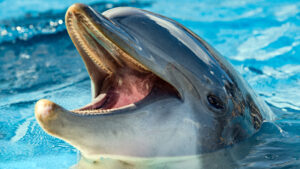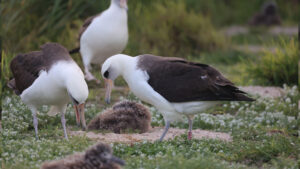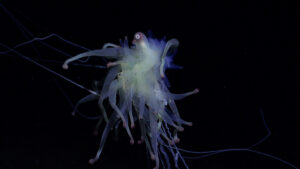A passion for the natural world drives many of our adventures. And when we’re not actually outside, we love delving into the discoveries about the places where we live and travel. Here are some of the best natural history links we’ve found this week.
Snow is glowing in the Russian Arctic: Biologist Vera Emelianenko was at a field station in the Russian Arctic, near the White Sea, when she noticed something peculiar. The snow was glowing. Footprints in the snow turned blue. She made a snowball in her hand, and as she squeezed, it glowed brighter. Under a microscope, she discovered copepods that displayed bioluminescence when you disturbed them. Solving one mystery created another. These copepods do not live near the shores of the White Sea but in open water. They spend daylight hours up to 100m below the surface. Scientists think that they were caught in powerful currents and swept ashore. Copepods are passive swimmers: Unable to resist currents, they would have no way of returning to the sea.
Coral reefs in Nevada
Fossils from the world’s first reefs found on mountains in Nevada: In the mountains of Nevada, you can find the fossilized ruins of ancient coral reefs. It seems impossible to imagine an underwater ecosystem not far from Death Valley, an area known for its almost unbearable temperatures. But 520 million years ago, the Cambrian explosion brought with it an abundance of life, and the mountains were the seafloor. In this ancient sea, animal-built reefs flourished. “You’re in the desert walking around on mountains, but at the same time you feel like you’re scuba diving,” says paleontologist Emmy Smith. To passersby, the rocks look like just rocks. You need a microscope to discern evidence of these remarkable organisms.

Glaciers in the Himalaya are melting at an unprecedented rate. Photo: Shutterstock
Himalayan Glaciers melting at an exceptional rate: Glaciers in the Himalaya are shrinking more quickly than those in other parts of the world. In the last few decades, they have lost ice 10 times more quickly than in the last 150 years. Their area has receded by 40%. The new findings are not just another reminder of human-induced climate change; they have serious implications. The loss of the glacial ice threatens a water supply that millions of people across Asia rely upon.
Dinosaur embryo found inside a fossilized egg: Researchers discovered a well-preserved dinosaur embryo inside a fossilized egg. The egg was in storage for 10 years and rediscovered when boxes of fossils were being sorted for a new Natural History Museum in China. The embryo is an oviraptorosaur, part of the theropod group of dinosaurs. The embryo displayed a tucking posture in the egg. Scientists thought this behavior was unique to birds. Interestingly, birds are originally descendants of theropods.

The oviraptorosaur embryo. Photo: Lida Xing/IScience
An abundance of shrews
Fourteen new species of shrew discovered: Scientists have found 14 new species of shrew on the island of Sulawesi, Indonesia. They examined 1,368 specimens and found evidence of 21 separate species. Seven of these have been previously identified. There are now 461 known species of shrew across the world. Though it was exciting to discover so many new species, scientists also said it was quite overwhelming. Studying the specimens took eight years, and for most of that, the number of distinct species was unclear.
Preserving the ‘Last Ice Area’

The Last Ice Area, northern Ellesmere Island: still plenty of summer sea ice. Photo: Jerry Kobalenko
Can scientists develop an icy sanctuary for arctic life? Polar bears are struggling to cope in the ever-warming Arctic. They also faced extinction 130,000 years ago, but they bounced back after the warming period ended. This knowledge has prompted an ambitious plan. Scientists want to create a sanctuary for ice-dependent species in the area known as ‘the Last Ice Area’. Computer modeling suggests this area will retain its sea ice indefinitely if the planet doesn’t warm more than 2˚C above pre-industrial levels. If successful, this summer ice will serve as a floating refuge that is legally protected against commercial activities.

Reindeer. Photo: Shutterstock
Why reindeer are perfect to pull Santa’s sleigh: Reindeer are crucial to the success of Santa Claus. But why did he choose them to pull his sleigh over every other animal? The biology of reindeer makes them perfect for the job. Living in the Arctic, they can withstand temperatures well below -30˚C. They have two layers of fur, and one square centimetre can have over 2,000 hairs. Unlike many other arctic animals, they don’t need to store lots of fat. They feast on reindeer lichen, which is plentiful throughout winter. They are one of the only known mammals able to digest this food source. Reindeer can see in ultraviolet and are some of the only mammals that have evolved this ability. In winter, their eyes change color from gold to blue, adapting to the shorter daylight hours. The ability to see in the dark makes them perfect for guiding a sleigh at night.






